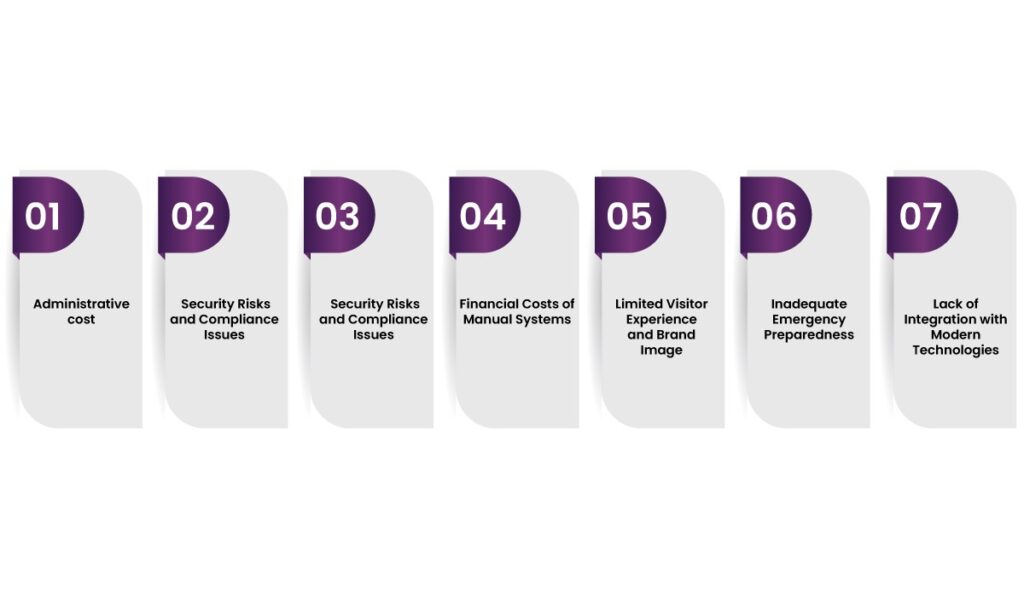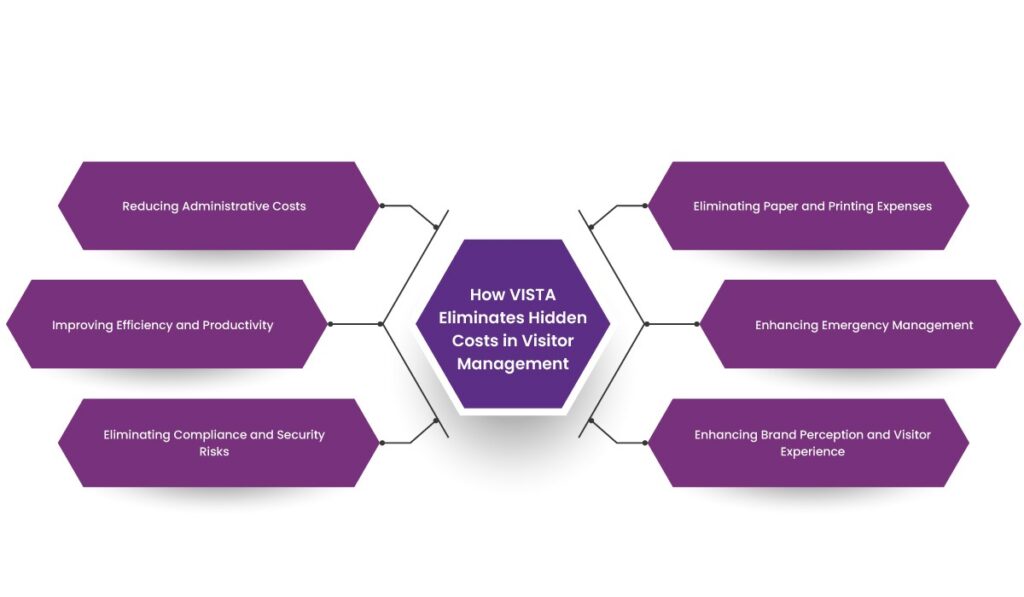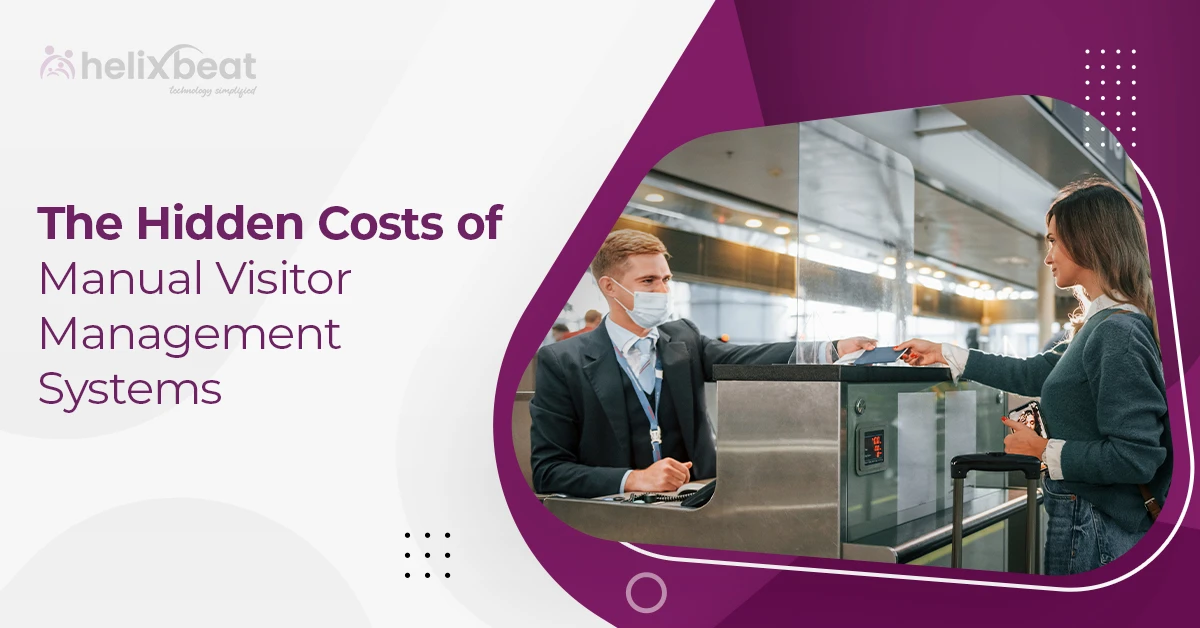Think about the last time you walked into an office and had to scribble your details in an old-school logbook. It might seem like a harmless, simple way to track visitors, but have you ever considered the hidden costs behind this manual system? From security risks to wasted time and mounting administrative expenses, traditional visitor management is more expensive than it looks.
Imagine this: A receptionist spends six minutes checking in every visitor. Multiply that by dozens or even hundreds of guests per month, across multiple locations, and you’re looking at hours of lost productivity—and a hefty price tag. Not to mention the compliance risks, frustrating delays, and poor first impressions it creates.
In this article, we’re uncovering the true costs of manual visitor management system and why upgrading to a digital system isn’t just smart—it’s a game-changer for your business. Let’s dive in!
Table of Contents
Hidden cost of manual visitor management system
Administrative cost
a) Calculating Cost Savings
Using manual visitor management will take time-consuming process
A receptionist earning $15/hour spends six minutes per visitor on manual sign-ins. With 100 visitors monthly per location, automation saves $3,300 per month per location.
By implementing pre-registration features and QR code scanning, you can reduce check-in times, further enhancing efficiency.
b) Eliminating Manual Reporting and Audit Preparation
Another benefit comes from consolidating visitor data into a single platform—allowing you to eliminate the need for manual reporting and audit preparation. This streamlines compliance management, saves time, and reduces administrative burden.
2. Security Risks and Compliance Issues
a) Unauthorized Access
Manual sign-in sheets can be easily manipulated, lost, or ignored. Visitors can falsify information, enter restricted areas, or remain unaccounted for in case of an emergency. This lack of security exposes businesses to theft, data breaches, and unauthorized access.
b) Compliance Failures
Organizations in industries like healthcare, finance, and IT must adhere to strict compliance standards such as HIPAA, GDPR, and ISO. A manual VMS does not offer the necessary tracking, audit logs, or authentication required for regulatory compliance. Failure to comply can result in hefty fines and legal issues.
Examples of non-compliance costs:
- CCPA penalties: $2,500 per infraction
- PCI DSS fines: Up to $100,000 per month
- ITAR violations: $1 million or up to 10 years in prison
- GDPR fines: Up to €4 million or 20% of annual turnover
- FSMA violations: Court actions, seizures, suspension of facility’s food registration
c) Data Privacy Risks
A physical logbook displays visitor names, times, and reasons for visits, making sensitive information visible to others. This violates privacy laws and can create a legal liability if visitor data is misused or exposed.
3. Inefficiency and Time Wastage
a) Slow Check-in Process
A front-desk staff manually entering visitor details is time-consuming. This leads to long queues, frustrated guests, and decreased productivity for receptionists and security personnel.
b) Repetitive Administrative Tasks
Receptionists often have to manually check visitor identities, record arrival and departure times, print visitor badges, and notify employees. This routine takes valuable time away from their core responsibilities, leading to inefficiencies in daily operations.
c) Poor Record-Keeping
Manual logs can be misplaced, damaged, or illegible. Searching for past visitor records becomes a nightmare, making it difficult to retrieve critical information when needed for security audits or investigations.
4. Financial Costs of Manual Systems
a) Increased Labor Costs
Since a manual VMS requires constant human intervention, businesses must employ full-time staff at reception or security desks. These additional labor costs add up over time and reduce the overall efficiency of the workforce.
b) Errors and Penalties
Misspelled names, incorrect timestamps, and missing visitor logs can lead to miscommunication, compliance breaches, and operational inefficiencies. In industries with strict regulatory requirements, these mistakes can result in penalties and fines.
c) Paper and Printing Expenses
Printing visitor logs, maintaining physical files, and issuing paper badges incur recurring expenses. While the costs may seem minimal per visitor, they accumulate significantly over months and years.
5. Limited Visitor Experience and Brand Image
a) Frustration for Guests
Visitors often find manual sign-in processes outdated, cumbersome, and inefficient. Lengthy wait times, unclear instructions, and the lack of a seamless experience can leave a negative first impression.
b) Poor Brand Perception
Modern businesses leverage technology to enhance operations. A company still using a logbook may appear outdated, lacking innovation, and unprofessional compared to competitors with sleek digital visitor managementsystems.
c) Difficulty in Managing High Foot Traffic
Organizations hosting large events, conferences, or job fairs struggle with manual visitor sign-ins. A lack of streamlined check-in processes leads to crowding, delays, and chaos at entry points.
6. Inadequate Emergency Preparedness
a) Difficulty in Locating Visitors
In the event of an emergency such as a fire, security threat, or natural disaster, quickly identifying and evacuating all visitors is critical. With manual logs, it is nearly impossible to track real-time visitor locations.
b) Inefficient Emergency Response
Security teams and first responders rely on accurate data to manage crises. A manual VMS does not provide real-time visitor lists, delaying emergency responses and increasing risks.
7. Lack of Integration with Modern Technologies
a) No Integration with Access Control
Many organizations use digital access control systems, such as key cards or biometric scanners. A manual system cannot integrate with these technologies, leading to gaps in security and access tracking.
b) No Real-Time Visitor Insights
Modern VMS solutions offer analytics on visitor patterns, peak hours, and security risks. A manual system lacks data-driven insights, making it harder to optimize visitor flow and improve operational efficiency.
c) Ineffective Host Notifications
With a manual system, employees may not be notified immediately when a guest arrives. This causes delays, miscommunication, and an overall inefficient visitor experience.

How VISTA Eliminates Hidden Costs in Visitor Management
Many businesses overlook the hidden expenses of manual visitor management systems, including inefficiencies, security risks, compliance challenges, and unnecessary administrative work. VISTA helps streamline operations, reduce waste, and improve visitor experience, resulting in significant cost savings.
1. Reducing Administrative Costs
Manual visitor check-ins require staff to handle paper logs, badge printing, data entry, and approvals, which leads to:
- Increased labor costs due to time spent on manual check-ins
- Recurring expenses for paper logbooks, visitor badges, and storage
- Risk of errors and misplaced visitor records
How VISTA Helps:
- Automated pre-registration allows visitors to check in ahead of time
- Self-service kiosks reduce the need for reception staff involvement
- Digital visitor logs eliminate paper records and manual data entry
- On-demand badge printing prevents unnecessary printing costs
Outcome: Businesses significantly cut administrative expenses, allowing employees to focus on more critical tasks.
2. Improving Efficiency and Productivity
Traditional visitor management systems often cause delays, leading to long queues, frustrated guests, and reduced staff efficiency. The time wasted in manual processes results in:
- Visitors spending unnecessary time at reception
- Employees being interrupted to assist visitors
- Delays in meetings due to slow check-in processes
How VISTA Helps:
- Instant QR code check-ins allow visitors to enter quickly
- Automated visitor approvals remove unnecessary wait times
- Touchless check-in options improve speed and hygiene
Outcome: Faster visitor processing improves productivity and enhances the visitor experience.
3. Eliminating Compliance and Security Risks
Industries such as healthcare, finance, corporate offices, and government institutions must comply with regulations like GDPR, HIPAA, and ISO. Manual visitor management increases the risk of:
- Unauthorized access due to poor identity verification
- Data breaches and privacy violations from lost or mishandled records
- Compliance fines resulting from incomplete or missing visitor logs
How VISTA Helps:
- Secure digital visitor logs ensure encrypted and tamper-proof records
- Automated compliance reporting simplifies audits and legal documentation
- Facial recognition and ID verification enhance security
- Time-based visitor access restricts movement to authorized areas
Outcome: Businesses mitigate compliance risks, prevent security breaches, and avoid costly penalties.
4. Eliminating Paper and Printing Expenses
Paper-based visitor management systems come with ongoing costs for logbooks, badge labels, ink, and storage, which accumulate over time. Businesses lose money through:
- Constant replenishment of paper records
- High printing costs for visitor badges
- Storage space for physical visitor logs and difficulty retrieving data
How VISTA Helps:
- Digital badges replace printed visitor passes
- Cloud-based records eliminate the need for paper storage
- Electronic signatures and digital NDAs reduce printing requirements
Outcome: Businesses cut unnecessary expenses and reduce paper waste.
5. Enhancing Emergency Management
In an emergency such as a fire, lockdown, or medical incident, knowing who is on-site in real time is critical. Manual visitor logs create challenges because:
- They do not provide real-time visitor tracking
- Paper logs can be misplaced or outdated
- Visitor evacuations take longer without accurate headcounts
How VISTA Helps:
- A live visitor dashboard shows real-time occupancy
- Automated emergency notifications quickly alert all visitors
- Visitor headcount reports help ensure complete evacuation
Outcome: Faster emergency response and improved workplace safety.
6. Enhancing Brand Perception and Visitor Experience
A slow and outdated check-in process negatively affects brand reputation, making businesses appear inefficient. Common issues include:
- Long reception wait times causing frustration
- Paper-based sign-ins that feel unprofessional
- Security concerns over handwritten visitor logs
How VISTA Helps:
- Modern, digital check-ins provide a seamless experience
- Personalized visitor greetings enhance engagement
- Instant access approvals create a hassle-free process
Outcome: A professional and efficient visitor experience that enhances brand reputation.

Final words,
Let’s face it—manual visitor management systems are more trouble than they’re worth. From wasting time and money to creating security risks and compliance nightmares, the hidden costs add up fast. Think about it: Do you really want your receptionist drowning in paperwork when they could be focusing on more important tasks?
Switching to a digital visitor management systems isn’t just about keeping up with the times; it’s about boosting efficiency, enhancing security, and making a great first impression. With automation, real-time tracking, and seamless check-ins, you eliminate unnecessary hassles and create a smoother experience for everyone.
So, why stick with an outdated system when a smarter solution exists? Investing in a digital visitor management systems like VISTA isn’t just an upgrade—it’s a game-changer. Ready to say goodbye to inefficiencies and hello to a seamless, cost-effective visitor experience? It’s time to make the switch!
Frequently Asked Questions
- What are the hidden costs of manual visitor management?
Manual systems lead to security risks, compliance failures, administrative inefficiencies, and increased labor costs.
- How does a digital visitor management system save money?
It reduces administrative work, eliminates paper expenses, improves efficiency, and minimizes compliance penalties.
- What security risks are associated with manual visitor logs?
Unauthorized access, data breaches, and lost visitor records can compromise workplace security and compliance.
- How does manual visitor tracking impact productivity?
Receptionists spend valuable time on check-ins, creating delays and inefficiencies in daily operations.
- Can manual visitor logs lead to compliance violations?
Yes, they lack proper tracking, audit logs, and security measures, leading to potential fines and legal issues.
- What industries benefit the most from digital visitor management?
Healthcare, finance, corporate offices, government institutions, and high-security facilities benefit significantly.
- How does a digital system improve visitor experience?
It speeds up check-ins, reduces wait times, provides touchless options, and enhances overall security.
- Is a digital visitor management system difficult to implement?
No, most systems are user-friendly, easy to integrate, and require minimal training for staff and visitors.














